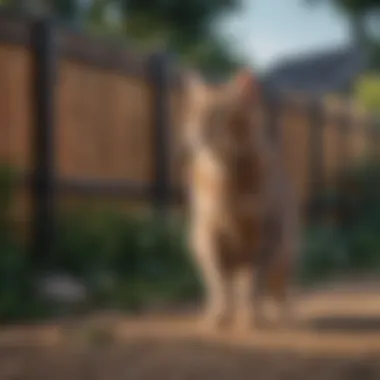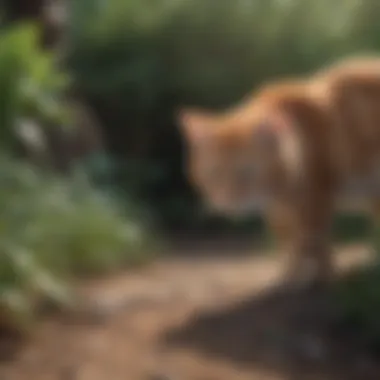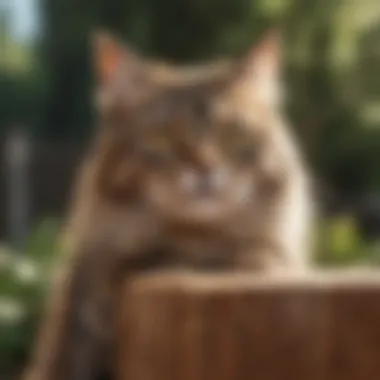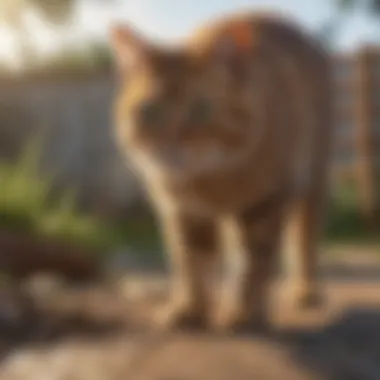Effective Strategies to Cat Proof Your Yard


Intro
Cats are beloved companions for many people, yet ensuring their safety when they explore the great outdoors can be daunting. Cat owners often face challenges like protecting their pets from potential dangers, be they wildlife, traffic, or other threats. Consequently, cat-proofing one’s yard becomes a priority. This process not only keeps our feline friends safe but also allows them to enjoy the fresh air, sunlight, and natural environment. The focus of this article will be to furnish pet owners with effective strategies for creating a secure outdoor space, ensuring the well-being of their cats while also considering the upkeep and enjoyment of their yards.
Understanding Feline Nature
Cats are inherently curious creatures, driven by instinct to explore their surroundings. Understanding their behavior is critical before implementing any cat-proofing techniques. Their physical agility allows them to easily climb, jump, and squeeze through tight spaces. Hence, cat owners need to think creatively when devising safety measures.
Common Risks in Outdoor Spaces
- Traffic: Roads and driveways pose a significant risk for roaming cats.
- Wild Animals: Encounters with wildlife can lead to injury or disease.
- Toxic Plants: Several common garden plants can be harmful or fatal if consumed.
- Stray Animals: These animals may be hostile and pose threats to your cat's safety.
To mitigate these risks, a combination of barriers, monitoring strategies, and environmental modifications is essential.
Key Cat-Proofing Strategies
Installing Fencing
An effective way to keep cats safe within a yard is to install a strong, tall fence. A good height to consider is six feet. It is also beneficial to tilt the top of the fence inward to deter climbing. Using materials such as chain link, wood, or vinyl can ensure that the fence is both sturdy and durable. Additional features like lattice or overhangs can further enhance security.
Natural Barriers
Creating natural barriers using plants can also be effective. Certain thorny shrubs or dense plantings can help keep cats confined. Some options include:
- Holly bushes are difficult to traverse due to their sharp leaves.
- Rose bushes provide a prickly deterrent.
Cat Enclosures or Catio Systems
Building an enclosed area or a "catio" can offer a safe environment for indoor cats. These semi-outdoor structures allow cats to experience nature while being protected from threats. Portable or permanent options existed depending on one's yard space. Ventilation and the availability of shelter from sun or rain are important features to include.
Behavioral Considerations
Understanding feline instincts helps in making informed decisions about cat-proofing. Cats may try to escape due to boredom or lack of stimulation in the yard. To combat this, consider the following:
- Incorporate scratching posts or climbing structures to engage their natural behaviors.
- Provide toys or puzzles to keep mental stimulation high.
Maintaining a Safe Environment
Creating a secure yard is just the beginning. Regular inspections are needed to maintain safety. Make sure to monitor the following:
- Check for any potential escape points as cats can find the slightest openings.
- Ensure that there are no toxic plants or hazardous chemicals within reach.
By implementing these strategies, cat owners can create a safe outdoor haven for their pets while ensuring their own enjoyment of the yard.
Creating a safe outdoor space for your cats not only enhances their quality of life but also provides peace of mind for their owners.
Understanding the Need to Cat Proof
Ensuring the safety and well-being of outdoor cats is critical for their health and happiness. As natural explorers, cats often find themselves in unpredictable environments, which can lead to encounters with dangers that may be harmful or even fatal. Understanding the need to cat proof your yard involves recognizing these risks and the benefits of creating a secure outdoor haven for your feline companions.
The Risks Associated with Outdoor Cats
Outdoor cats face numerous dangers that can impact their lifespan and overall peace of mind. Some of the significant risks include:
- Traffic: Many cats suffer injuries or fatalities from being struck by vehicles. High-traffic areas pose an especially severe threat.
- Predators: Larger animals, such as coyotes and hawks, can harm or prey on smaller domestic cats, particularly in suburban or rural areas.
- Diseases: Exposure to other animals can increase the risk of contagious diseases, such as feline leukemia, rabies, or parasites like fleas and ticks.
- Toxins: Many household plants and substances are toxic to cats. An untended garden can inadvertently expose your cat to these harmful items.
Being aware of these aforementioned risks underscores the importance of implementing effective cat-proofing strategies. It allows owners to make informed decisions regarding their yard's layout and management of potential hazards.
Benefits of a Safe Outdoor Space
Cat-proofing your yard grants multiple advantages, not just for your feline friend, but also for your peace of mind:
- Security: A well-protected area reduces the chances of dangerous encounters with wildlife or vehicles, allowing your cat to explore without fear.
- Health: A safe outdoor environment helps prevent injuries and illnesses associated with outdoor exploration, potentially prolonging your cat's life.
- Mental stimulation: Cats thrive on environmental enrichment. A secure outdoor space allows them to engage in natural behaviors like climbing, digging, and observing without the associated risks.
- Enhanced bonding: Spending time together in a cat-proofed yard fosters a stronger bond between you and your pet, as both can enjoy outdoor activities without concerns for safety.
In summary, understanding the need to cat proof your yard is about acknowledging the threats outdoor cats face and acting to mitigate them. By creating a secure outdoor space, you not only protect your cat but also enrich their life, leading to a happier and healthier companion.


Assessing Your Yard
Assessing your yard is crucial when it comes to ensuring the safety of your cat. This process involves identifying potential risks, mapping out your outdoor area, and understanding your feline's behavior. By carefully evaluating these elements, you can create a safer environment that minimizes dangers while still allowing your feline friend to enjoy the outdoors.
Identifying Potential Hazards
Potential hazards can take many forms in a yard. These may include toxic plants, sharp objects, open water, and even nearby roads. To effectively identify hazards, walk through your yard systematically.
- Plant Life: Many common plants like lilies and azaleas can be toxic to cats. Digging deeper into what is safe and what is not can prevent accidental poisoning.
- Sharp Objects: Check for broken glass, sharp tools, or debris that may cause injury. Even small pieces can be dangerous when your cat is playing or exploring.
- Water Hazards: If you have a pond or pool, ensure your cat cannot easily access these areas without supervision. Drowning is a grave risk, especially for untrained swimmers.
- Road Proximity: If your yard is close to a road, consider the risks associated with traffic. Cats are naturally curious and may wander too close to danger.
By recognizing these hazards, you can take targeted steps to mitigate the risks and keep your cat safe.
Mapping Your Outdoor Area
Creating a map of your outdoor space can help visualize not only the layout but also the potential hazards present. Start by drawing a simple outline of your yard, marking key features such as fences, gardens, and water sources. This will provide a better perspective on where potential dangers lie.
- Fences: Evaluate the condition and height of your fencing. A secure fence is essential for preventing escapes and keeping out unwanted animals.
- Play Areas: Identify areas designated for play. These should be both fun for your cat and clear of hazards.
- Shelters: Note existing shelters or spaces where your cat might hide. This can help you assess whether these areas are safe or need enhancement.
A clearly mapped yard not only aids in planning improvements but can also make it easier to keep your cat safe during outdoor excursions.
Analyzing Feline Behavior
Understanding how your cat behaves in your yard is fundamental to assessing your yard's safety. Different cats have varying levels of curiosity and risk tolerance. By observing your cat in its outdoor surroundings, you can gather insights into its interactions with the environment.
- Exploration Patterns: Notice where your cat spends most of its time. This may highlight safe zones as well as areas with potential risk.
- Curiosity: Pay attention to your cat’s affinity for specific plants or objects. If your cat often investigates certain areas, consider these spots when assessing risk.
- Reactions: Watch how your cat reacts to outdoor stimuli like sounds and movement. If it seems frightened, there may be nearby dangers or stressors.
Each observation can help you create a safer outdoor space tailored to your cat's unique behaviors.
"A little preparation goes a long way. Understanding your yard can mean the difference between a safe sanctuary and an unsafe environment for your cat."
Creating Physical Barriers
Creating physical barriers is a critical aspect of cat-proofing your yard. This section focuses on various methods that can effectively deter cats from wandering outside designated areas. Physical barriers not only help in ensuring the safety of your feline companions but also in preserving your outdoor environment from potential decay due to feline behaviors such as digging or climbing. Understanding the types of barriers ensures that your efforts lead to a secure space, giving you peace of mind.
Fencing Options for Cat Safety
Types of fences
A variety of fences can serve as an effective solution to keep cats safe within their yard. Common options include wooden, vinyl, chain-link, and even electric fencing. Each type of fence has unique characteristics that may make them suitable for different situations.
Wooden fences are often robust and can provide an aesthetic appeal, while chain-link fences may be more economical and functional. The benefit of a wooden or vinyl fence is that it can be made taller and sturdier, reducing the risk of a cat jumping over. Each type offers benefits and drawbacks; for instance, while wooden fences provide privacy, they may require more maintenance.
Height considerations
Height is a significant consideration when choosing a fence. A taller fence is generally better for preventing cats from jumping over it. Cats are capable of leaping several feet, so a minimum height of six feet is advisable. This height discourages escape but should also be aesthetically pleasing to the homeowner.
However, excessive height may shift focus away from your yard's overall design and can become more challenging to install. Thus, balancing safety and design aesthetics is vital for a successful installation.
Materials to use
The material of your fence plays a crucial role in its effectiveness. Most homeowners choose durable materials like wooden boards, vinyl panels, or chain-link mesh that can withstand outdoor elements. Each of these materials has unique benefits.
For example, vinyl is resistant to weathering, which means it maintains its appearance longer. However, wooden fences may require regular treatment to help protect against rot. Ultimately, selecting the right material contributes to the longevity and effectiveness of your cat-proofing efforts.
Using Natural Barriers
Plants that deter cats
Incorporating specific plants in your yard can serve as natural boundaries. Plants such as rosemary, lavender, and coleus canina possess odors that cats generally find unpleasant. These plants not only provide a natural repellent but also add beauty to your garden.
The key characteristic of these plants is their natural deterrent properties. However, it’s important to note that while they can discourage cats, they may not provide a complete solution on their own, particularly in areas where cats are consistently curious.
Landscaping techniques
Proper landscaping can also contribute to keeping cats within safe boundaries. Creating dense plantings or sharp-edged beds can limit the space where cats may feel comfortable wandering. Using gravel or mulch around garden beds can deter digging and create an unattractive surface for cats to walk on.
One effective technique is to design your yard with certain raised flower beds. These elevated areas can limit access, while also beautifying your space. The consideration here is to maintain a balance between functionality and visual appeal to avoid an overly cluttered landscape.


This thoughtful approach to creating physical barriers through fencing and natural elements can effectively contribute to a safer yard environment for cats while respecting the overall aesthetic of the property.
Employing Deterrents and Repellents
Deterrents and repellents are crucial tools in the effort to cat-proof your yard. They help manage the behaviors of outdoor cats, keeping them away from areas where they might encounter hazards or engage in unwanted activities. The significance of employing such methods lies in their ability to create a safer environment not only for your feline friends but also for local wildlife and plants. Utilizing these tools can greatly reduce the risks associated with free-roaming cats while allowing for a more peaceful coexistence with nature.
Chemical Repellents
Chemical repellents are products designed to discourage cats from entering certain areas or engaging in certain behaviors. These substances may work by emitting odors that are unappealing to cats or causing them discomfort when they make contact with them. Before selecting a chemical repellent, consider the following points:
- Effectiveness: Different repellents will work differently depending on the individual cat’s preferences and sensitivities. Some may be more effective than others.
- Safety: Always choose repellents that are safe for both animals and plants. Look for products labeled as non-toxic or organic.
- Longevity: Some repellents may require frequent reapplication, especially after rain. It is important to consider how often you are willing to maintain the repellent application.
Popular options for chemical repellents include:
- Citrus sprays: Many cats dislike citrus scents. A spray made from citrus peels can be effective.
- Vinegar solutions: The strong scent of vinegar may deter cats from visiting certain areas.
- Commercial repellents: Products specifically designed for cats are often available in pet stores. These can be effective but check the ingredients carefully.
Motion-Activated Devices
Motion-activated devices offer another innovative approach to cat-proofing. These gadgets can detect movement and activate a deterrent response that discourages cats from entering specific areas. Such devices can include:
- Sprinklers: Motion-activated sprinklers can release a burst of water when they detect movement. Most cats are startled by sudden water and will quickly leave the area.
- Sound devices: Some devices emit a sound that is unpleasant for cats but inaudible to humans. This noise can effectively scare cats away from undesired locations.
- Vibrating mats: Mats equipped with sensors can activate a vibration when a cat steps on it, which can scare them off.
When considering motion-activated devices, keep these factors in mind:
- Positioning: Placement is key for effectiveness. Ensure devices are positioned where cats are likely to approach.
- Height and Range: Check the height and motion-sensing range of the device to confirm it will function correctly within your space.
- Weather Resistance: Opt for devices that are weather-proof if they will be outdoors.
Using deterrents and repellents is part of a comprehensive strategy for cat-proofing your yard. They can mitigate risks and provide a balance between the natural world and a safe outdoor space for your cats.
Incorporating Safe Zones
Creating safe zones within your yard is essential for providing a protective environment for your cat. Safe zones not only ensure the security of your pet but also enhance their overall quality of life. This section will delve into two primary aspects of incorporating safe zones: building cat shelters and creating enclosed garden spaces.
Building Cat Shelters
Building cat shelters can act as a refuge for your feline. These shelters provide a safe space where your cats can hide, relax, and feel secure, especially when facing potential dangers. Cat shelters can be made from various materials, which influence their durability and comfort level.
Materials for cat shelters
Choosing the right materials is crucial when constructing cat shelters. Common choices include wood, plastic, and insulated panels. Wood, for instance, is a favorite among many builders due to its sturdiness and natural appeal. It can hold up well against various weather conditions, making it a beneficial choice for outdoor setups. On the other hand, plastic is lightweight and easy to clean, but lacks the insulation properties that a cat shelter might require during colder months. Lastly, insulated panels provide superior protection against temperature extremes, ensuring your cats remain comfortable year-round. However, these can be heavier and more expensive.
Design considerations
Design is another critical factor in building effective cat shelters. It is important to consider the size, shape, and accessibility of the shelter. A well-designed shelter should have sufficient space for your cats to move around while being cozy enough to offer a sense of security. A popular design feature includes multiple entries and exits, allowing for an escape route if needed. One of the advantages of such shelters is that they can be adapted to fit various landscapes and personal tastes. Yet, it is crucial to avoid overly complicated designs that may deter your cat from using the shelter altogether.
Creating Enclosed Garden Spaces
Creating enclosed garden spaces can effectively allow your cats to enjoy the outdoors while keeping them safe from potential threats. These areas should be designed thoughtfully to meet the needs of your cats while being manageable for you as an owner. Enclosed spaces can include special fencing or netting that prevents cats from escaping while providing ample room to explore.
Such spaces can also incorporate natural elements like plants or shallow water features, creating a stimulating environment. When creating these areas, ensure that all materials used are non-toxic and safe for feline interaction. By providing a secure and enriching outdoor experience, you can foster your cats' natural instincts without sacrificing their safety.
Ongoing Maintenance and Observation
Maintaining a cat-proof yard goes beyond initial installation. It requires ongoing attention and a proactive approach to ensure continued safety for your pets. Regular maintenance of both barriers and observed behavior can prevent accidents and identify any threats to your feline companions. This section discusses its importance, focusing on key elements and associated benefits.
Regular Checks for Safety
Conducting regular checks for safety is essential. This involves inspecting fences, barriers, and shelters to ensure they are intact and functioning properly. Weather conditions, like heavy rains or strong winds, can wear down physical structures. Look for any gaps, loose sections, or new potential hazards such as fallen branches.
Consider these aspects during your inspections:
- Fencing Integrity: Ensure that fences are not bent or broken. Pay attention to the base where the fence meets the ground to confirm that no burrowing has occurred.
- Shelter Condition: Regularly check shelters for signs of damage or decay. Wood can rot, and structural materials may weaken over time.
- Landscaping: Assess the surrounding plants and trees. Some plants may grow or change in a way that could present risks. Remove any hazardous plants or debris that could harm the cats.
Monitoring Cat Behavior
Understanding feline behavior is critical to ensuring their safety in a cat-proof yard. Observing how your cats interact with the environment can provide insight into what adjustments are necessary. Some behaviors may indicate discomfort or danger, which may not be apparent otherwise.


Focus on these observations:
- Escape Attempts: Notice if your cats are attempting to escape or showing signs of anxiety. This could mean that certain areas need additional attention or reinforcement.
- Interaction with Wildlife: Monitor their reactions to nearby wildlife. If your cat frequently watches or tries to engage with animals outside your yard, it might be time to enhance barriers or use deterrents.
- Changes in Behavior: Watch for any shifts in behavior or mood. Unexplained changes can be a sign of underlying stress due to new stimuli or inadequacies in the cat-proofing measures.
"Continuous monitoring helps you adapt and ensure a safe haven for your cats, adjusting as their needs and the yard environment change."
By prioritizing ongoing maintenance and behavior monitoring, you create an environment that can adapt to the needs of your cats while keeping them safe from potential hazards. This proactive approach allows earlier detection and resolution of any issues that may arise.
Understanding Local Wildlife
When considering how to effectively cat-proof your yard, it is crucial to have a solid understanding of local wildlife. Many factors contribute to this, including the types of animals that inhabit your area and their behaviors. Recognizing these elements not only enhances the safety of your feline companions but also promotes a harmonious relationship between pets and their natural environment.
Potential Threats from Wildlife
The potential threats that wildlife poses to your cat cannot be overstated. From predatory birds such as hawks to neighborhood dogs, the list is extensive. Some common threats include:
- Predators: Larger wildlife, including coyotes and foxes, can pose a serious threat. These animals may see your cat not just as a pet but as prey.
- Disease: Wildlife can carry diseases like rabies or parasites like ticks that can easily affect your cat if they interact.
- Competition: Wild animals may compete for resources, particularly food, and water. This could lead to confrontations that can harm your pet.
Understanding these potential threats allows cat owners to prepare and adapt their outdoor spaces to minimize risks.
Coexistence Strategies
Educating yourself about local wildlife also opens the door to coexistence strategies that enable your cats to enjoy the outdoors safely. Here are some effective methods to consider:
- Fencing Solutions: Implementing a fence designed to keep both your cat in and wildlife out can be effective. Some cat-proof fencing systems are curved at the top to prevent climbing.
- Time Restrictions: Limit outdoor access during dusk and dawn when many predators are most active. Keeping a close eye on your pets during these times is also advisable.
- Creating Safe Zones: Enhance your yard by establishing protected areas where your cat can relax without the threats of wildlife. Shelter with safe wiring can help.
"Understanding the dynamics between your pets and local wildlife is essential for cat owners to foster safety and harmony in their yards."
Balancing the needs of your pet and the local ecosystem is a fine line to walk. Awareness and preparation are keys to a secure outdoor environment for your cat.
Legal and Ethical Considerations
In the context of cat-proofing your yard, understanding the legal and ethical considerations is paramount. Owning a cat imposes certain responsibilities, especially when it comes to ensuring their safety and the welfare of local wildlife. These considerations shape how one approaches yard modifications for felines and influence the overall enjoyment of your outdoor space.
Understanding Local Laws
Local laws regarding pet ownership can vary widely depending on your region. It is essential to be familiar with these regulations as they may dictate elements of yard design and cat management practices. For example, some areas may have zoning laws that restrict the type or height of fencing you can install. Others might require permits for building certain structures that could house animals.
Being informed about local laws will help avoid potential fines or complaints, ensuring a harmonious relationship with neighbors and local authorities.
Moreover, laws may protect wildlife, which is an important aspect when cat-proofing your yard. In some cases, allowing cats outdoors can put local bird populations or other wildlife at risk. Awareness of these laws will help you make decisions that align with community values.
Ethical Treatment of Animals
The ethical treatment of animals encompasses the well-being of both your cat and the local ecosystem. Ethically, it is crucial to provide a safe, enriching environment for your cat. This involves creating a yard that can serve as a secure play area while limiting their exposure to dangers posed by the outside world.
This means:
- Ensuring Cat Safety: Implement physical barriers and safe zones, which prevent your cat from straying into traffic or interacting with aggressive wildlife.
- Respecting Wildlife: Ensuring that modifications to your yard do not disrupt local habitats or ecosystems. Consider how to minimize any negative impacts, such as predation on birds or small mammals.
In addition to physical considerations, one must also contemplate the psychological aspects. Keeping your cat happy and engaged is vital for their mental health. Providing appropriate stimulation and sheltering options can help fulfill your responsibility as a pet owner.
Cat-proofing is not just about protection; it is also about fostering a relationship that respects all creatures involved. Combining legal insight with ethical perspectives can lead to a more harmonious outdoor environment for pets and wildlife alike.
Finale
The conclusion is a pivotal part of any article as it summarizes the core points discussed and reminds readers of the importance of implementing those strategies. In the context of cat-proofing a yard, the conclusion serves to reinforce why creating a safe outdoor environment is of paramount significance for both pet owners and their feline companions.
The safety of cats when they are outside cannot be overstated. With the increasing risk from traffic, predators, and other dangers, reflective practices in fortifying a yard become essential. Not only does cat-proofing protect our pets, but it also fosters a harmonious relationship with local wildlife. By creating barriers and safe zones, pet owners can ensure their cats explore their outdoor space while mitigating risks to both the cats themselves and surrounding ecosystems.
Recap of Key Strategies
As we have discussed throughout the article, there are several key strategies to effectively cat-proof your yard:
- Assessing your yard for potential hazards is the first step. Identify toxic plants, open holes, or anything that may pose a risk.
- Creating physical barriers such as fences is essential. Choose materials that are durable and suitable for your area. Ensure that the fences are tall enough to prevent escape and deep enough to stop digging.
- Incorporating deterrents and repellents can also be effective. Chemical repellents and motion-activated devices are useful tools to keep your cat safe.
- Ongoing maintenance and regular checks for safety cannot be overlooked. Monitor your yard frequently to ensure that it remains secure and free of potential threats.
By combining these strategies, cat owners create a secure and enjoyable environment.
Final Thoughts on Cat Safety
Ultimately, cat safety in outdoor spaces is a vital concern that goes beyond mere convenience. The proactive measures discussed throughout this article not only protect cats but also embrace a broader responsibility to wildlife and the environment. It involves a commitment to understanding the unique behaviors of cats, considering their needs, and acting in ways that foster safety and exploration.
Creating a cat-proof yard reflects an investment in the well-being of our pets. It allows them to enjoy nature while also ensuring their survival and minimizing disruption to the ecosystem around them. As such, continuous effort in these areas will pay dividends in the lives of both cats and the environments they inhabit.







